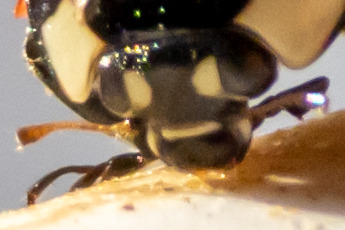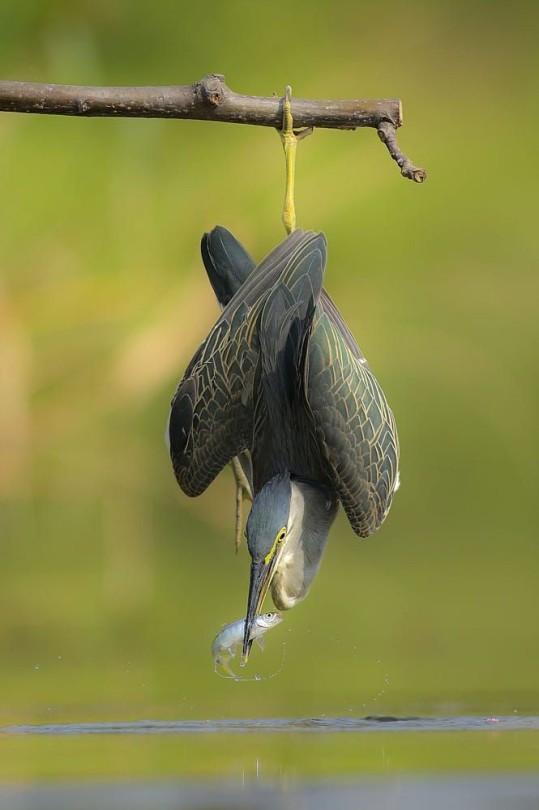The Paralyzed Cicadas I Picked Up From A Failed Cicada Killer Nest Are The Perfect Material To Show Off
the paralyzed cicadas I picked up from a failed cicada killer nest are the perfect material to show off some cool features of insect anatomy! (although the wasp’s venom would keep them alive for her larvae to eat, I froze them to make sure they’re fully dead for dissection).
cicadas are powerful, fast fliers, and all of their thorax is taken up by a bulk of reddish, stringy flight muscles, which I’ll talk more about later. this cicada is a female, so her abdomen is full of white, elongated eggs that she will insert into tree bark with the bladed ovipositor at her rear.


the male cicada’s abdomen, however, is almost entirely empty, and that air-filled space is used as a resonator for his loud calls. the biggest structure visible there is a curved pair of muscles that deforms the tymbals, producing a click with every contraction.


here's a view of the complete muscle, and the tymbals themselves which look like overlapping plates on his belly. if you're curious what the white frosted appearance is, some Neotibicen have a coat of waxy powder or pruinescence; this male N. tibicen is particularly pruinose.
onto the flight muscles:
powered flight is a pretty complex mechanism in any organism, and is never so simple as just flapping wings up and down, but most insects power their flight in a really unintuitive way (at least for us vertebrates): they contract muscles in their thorax that aren’t even attached to the wings!
this method of flight is called indirect flight, in contrast to the direct flight of the dragonflies and mayflies where each of four wings is directly attached to a muscle and can flap on its own.


instead, most insects have a longitudinal (image 1 above, d below) pair and a vertical (2, c) pair of muscles that deform the shape of abdomen, pulling the upper segment of the thorax (notum) up and down, and this moves the wings which are attached to the notum. useful indirect flight gif from wikipedia found here

even if compressed manually, the dead cicadas "flap" their wings due to the motion of the notum:

insect flight is a lot more complicated than this simplified look at them, but I think these cicadas offer a pretty good look at how most insects get around essentially by squishing themselves internally!
More Posts from Goblin-in-the-rain and Others

Lady bug on the tansy

Picasso Bug aka Zulu Hud Bug (Sphaerocoris annulus), family Scutelleridae, found in much of Sub-Saharan Africa
photograph by Daniel Rosengren Photography
Have you ever seen the pattern on a Macrodontia Cervicornis cuz like… holy shit


Trick or treat! < shaking with both excitement and terror
Your roommate for the entire year is a Creeper from Minecraft! Don't let it sneak up on you🥲







Feb - Apr 2025, different tree bark textures & colours
cat riding sheep

Ladybug (Coccinella septempunctata) close-up. As you can see, this Coleoptera has a skull painted on its head, just like a common heavy metal band member:

Many thanks to @sarcasm-andotherstuff for her pareidolic superpowers.
my writing fundamentally changed forever ten years ago when i realized you could use sentence structure to control people’s heart rates. is this still forbidden knowledge or does everyone know it now
-
 latenightroa reblogged this · 1 week ago
latenightroa reblogged this · 1 week ago -
 latenightroa liked this · 1 week ago
latenightroa liked this · 1 week ago -
 cerothenull liked this · 2 weeks ago
cerothenull liked this · 2 weeks ago -
 sawvidae reblogged this · 2 weeks ago
sawvidae reblogged this · 2 weeks ago -
 lizardlesbians reblogged this · 2 weeks ago
lizardlesbians reblogged this · 2 weeks ago -
 bunnyypeach reblogged this · 2 weeks ago
bunnyypeach reblogged this · 2 weeks ago -
 atriphiyde liked this · 2 weeks ago
atriphiyde liked this · 2 weeks ago -
 theconstellationsinyourskin reblogged this · 2 weeks ago
theconstellationsinyourskin reblogged this · 2 weeks ago -
 theconstellationsinyourskin liked this · 2 weeks ago
theconstellationsinyourskin liked this · 2 weeks ago -
 strigops reblogged this · 2 weeks ago
strigops reblogged this · 2 weeks ago -
 korethena liked this · 3 weeks ago
korethena liked this · 3 weeks ago -
 yaiyogsothoth reblogged this · 3 weeks ago
yaiyogsothoth reblogged this · 3 weeks ago -
 yaiyogsothoth liked this · 3 weeks ago
yaiyogsothoth liked this · 3 weeks ago -
 thisismyideaofhumor reblogged this · 3 weeks ago
thisismyideaofhumor reblogged this · 3 weeks ago -
 avianhaven liked this · 3 weeks ago
avianhaven liked this · 3 weeks ago -
 warmitte liked this · 1 month ago
warmitte liked this · 1 month ago -
 queen-elizabeth-3st liked this · 1 month ago
queen-elizabeth-3st liked this · 1 month ago -
 urcaptainvrodani reblogged this · 1 month ago
urcaptainvrodani reblogged this · 1 month ago -
 padingo liked this · 1 month ago
padingo liked this · 1 month ago -
 skallyeen reblogged this · 1 month ago
skallyeen reblogged this · 1 month ago -
 meowmrrrrp reblogged this · 1 month ago
meowmrrrrp reblogged this · 1 month ago -
 meowmrrrrp liked this · 1 month ago
meowmrrrrp liked this · 1 month ago -
 tenbirdsinatrenchcoat liked this · 1 month ago
tenbirdsinatrenchcoat liked this · 1 month ago -
 buteonine reblogged this · 1 month ago
buteonine reblogged this · 1 month ago -
 partyhatvillain liked this · 1 month ago
partyhatvillain liked this · 1 month ago -
 connoruniverse232 liked this · 2 months ago
connoruniverse232 liked this · 2 months ago -
 ocularskewer reblogged this · 2 months ago
ocularskewer reblogged this · 2 months ago -
 ocularskewer liked this · 2 months ago
ocularskewer liked this · 2 months ago -
 21oopsadaisies liked this · 2 months ago
21oopsadaisies liked this · 2 months ago -
 amazinglyawsomesauce liked this · 3 months ago
amazinglyawsomesauce liked this · 3 months ago -
 changeling-chatter reblogged this · 3 months ago
changeling-chatter reblogged this · 3 months ago -
 knightskaii liked this · 3 months ago
knightskaii liked this · 3 months ago -
 abirdsnest reblogged this · 3 months ago
abirdsnest reblogged this · 3 months ago -
 abirdsnest liked this · 3 months ago
abirdsnest liked this · 3 months ago -
 whale-in-that-case reblogged this · 3 months ago
whale-in-that-case reblogged this · 3 months ago -
 colimbae reblogged this · 3 months ago
colimbae reblogged this · 3 months ago -
 xcoffeepostx liked this · 3 months ago
xcoffeepostx liked this · 3 months ago -
 bloggingbulbasaur reblogged this · 3 months ago
bloggingbulbasaur reblogged this · 3 months ago -
 plaguerightsactivist reblogged this · 3 months ago
plaguerightsactivist reblogged this · 3 months ago -
 cuttlefishen reblogged this · 3 months ago
cuttlefishen reblogged this · 3 months ago -
 snowgyr liked this · 3 months ago
snowgyr liked this · 3 months ago -
 normalpoolnoodle reblogged this · 3 months ago
normalpoolnoodle reblogged this · 3 months ago -
 ajthenerd reblogged this · 3 months ago
ajthenerd reblogged this · 3 months ago -
 ajthenerd liked this · 3 months ago
ajthenerd liked this · 3 months ago -
 stubbornseedling liked this · 3 months ago
stubbornseedling liked this · 3 months ago -
 lookupbin reblogged this · 3 months ago
lookupbin reblogged this · 3 months ago -
 theenchantedforestsystem reblogged this · 3 months ago
theenchantedforestsystem reblogged this · 3 months ago -
 lirulua liked this · 3 months ago
lirulua liked this · 3 months ago -
 plaguerightsactivist liked this · 3 months ago
plaguerightsactivist liked this · 3 months ago -
 astarlingdiscovery reblogged this · 3 months ago
astarlingdiscovery reblogged this · 3 months ago

Hi it’s me puddleorganism if you’re confused why you got a billion hoops from me
298 posts
